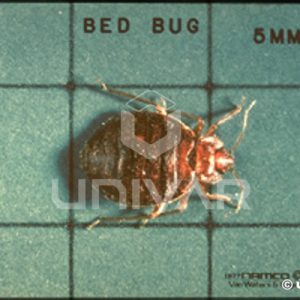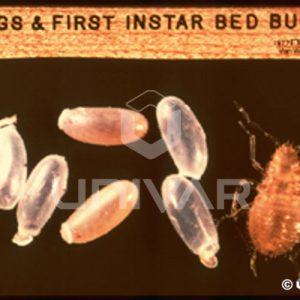
Common Name: Bed Bug – Common Bed Bug
Latin Name: Cimex lectularius
Common Family Name: Bed bugs
Latin Family Name: Cimicidae
Other Names: Chinches, mahogany flats, red coats, crimson ramblers
Origin: It is believed that this bug originally evolved with bats living in caves in the Middle East, but in the United States it appears now to be wholly a human pest. It has been associated with humans for thousands of years.
Biology: While this species is not associated with the spread of any diseases, its bite can have a serious effect on people who are sensitive to its saliva, and swelling and severe itching or other immune system reactions may be common. The bite itself is generally painless. The Human bed bug is nocturnal, feeding only at night when people are asleep. During the daylight hours it hides in any available crack or hole in the immediate area. The presence of bedbugs may be determined by an unusual “sweet” odor in the room. Females lay their eggs by gluing them to hidden surfaces, laying several eggs each day with a total of about 200 eggs. There are 5 instar stages to the nymphs, and the growth to the adult stage takes about a month and a half, although in the absence of a blood source the nymph may lay dormant for long periods. The adults can live over a year, and in the absence of human hosts they have been known to feed on birds and rodents.
Identification: Bed bugs in general are wingless insects with an extremely flattened body from top to bottom, except when they are engorged with blood. They have a large, round abdomen, long 4-segmented antennae, and a small prothorax that flares to the sides. Their mouth is a short, 3-segmented proboscis that is held below the body when at rest. The human bed bug is distinguished from other species by the antennae, where the last segment is shorter than the segment before it, the fringe of hairs along the sides of the pronotum are very short, and the front of the pronotum is deeply concave. Evidence may include bites on occupants of the structure, although a PMP should not attempt to diagnose a bite mark. There also are often small spots of blood on sheets or mattresses, left by the departing bug following its meal. Feeding by adults may last for around 15 minutes.
Characteristics Important in Control: Control relies on a thorough inspection of a structure to determine hiding places of the bugs, thorough cleaning of mattresses and bed coverings, and a thorough application of a residual insecticide to all possible cracks, crevices, holes, or other hiding places in the room. Vacuuming with a high-powered vacuum will help to remove many of the pests that are hiding.
Because of their elusive nature, bed bugs are easily overlooked by unsuspecting property owners and managers. Our Bed Bug Canine Inspections allow for quicker, more accurate detection of bed bugs and, because they are extremely difficult to eradicate, our bed bug services include the necessary products and follow-up visits for one fee. Our treatment methods consist of the following:
Manual Services:
- The most cost-effective choice for: Immediate treatment of select areas within a structure or home.
- Resident preparation: Requires extensive preparation by the resident.
- Chemical applications: This process can be accomplished with or without chemicals.
Heat Treatment Services:
- The most cost-effective choice for: Resolving heavy infestations in cluttered conditions. Heat has been proven to kill all stages of the bed bug, from egg to adult, usually in just one visit.
- Resident preparation: Less extensive preparation is required for the resident and they can return to their home that same day.
- Chemical applications: The primary method of treatment is chemical-free heat. We may include the use of a natural-chemical treatment called Diatomaceous Earth, which is a naturally occurring dust that kills bed bugs and other nuisance pests physically, not chemically.
Fumigation Services:
- The most cost-effective choice for: The treatment of heavy infestations in large structures.
- Resident preparation: Less extensive preparation is required for the resident. Residents must vacate the structure for 24-48 hours without re-entering.
- Chemical applications: Sulfuryl Fluoride (Vikane®)









